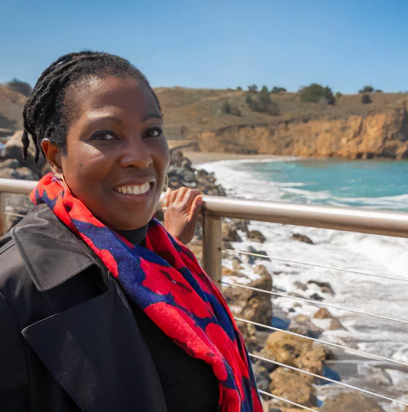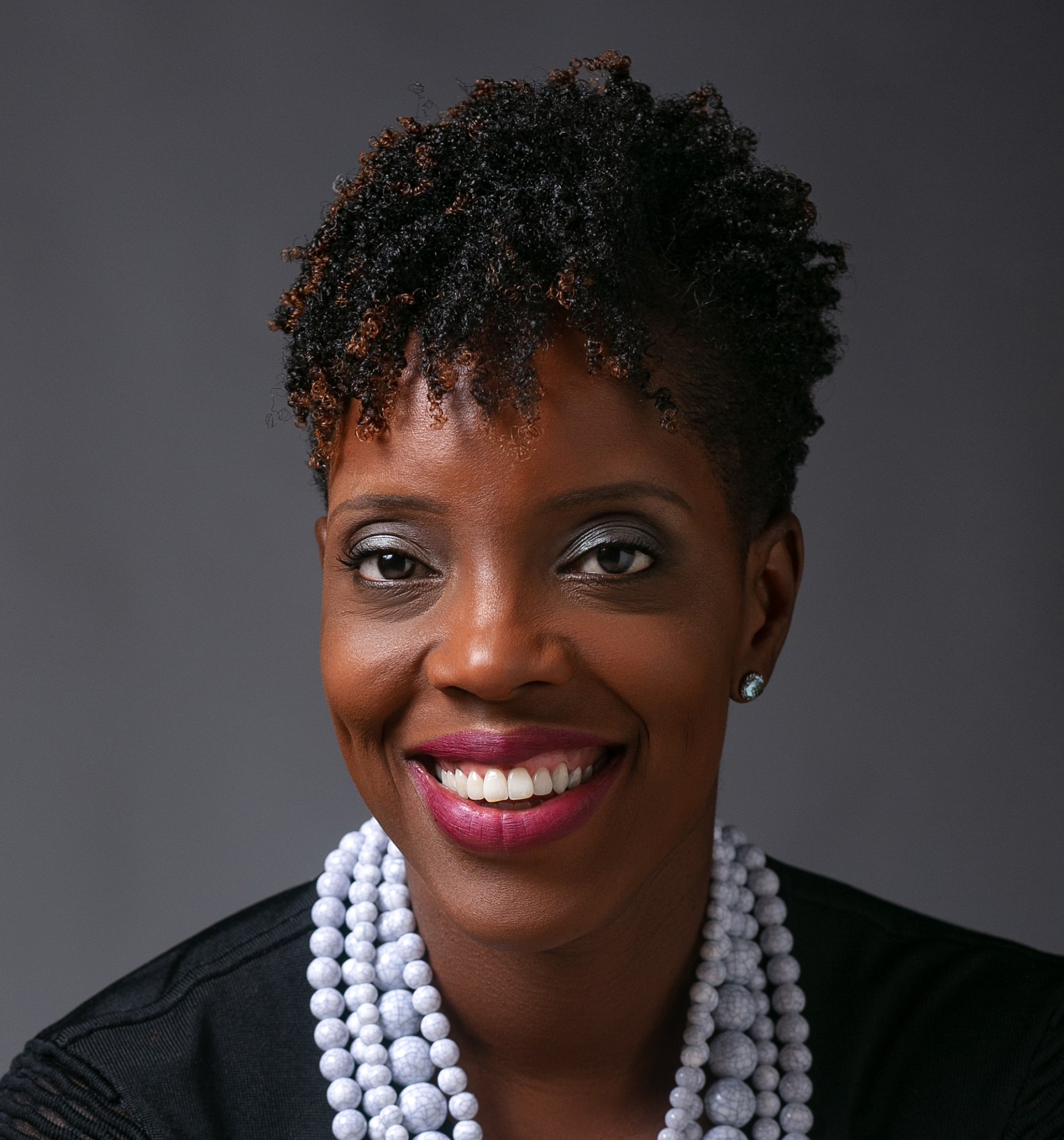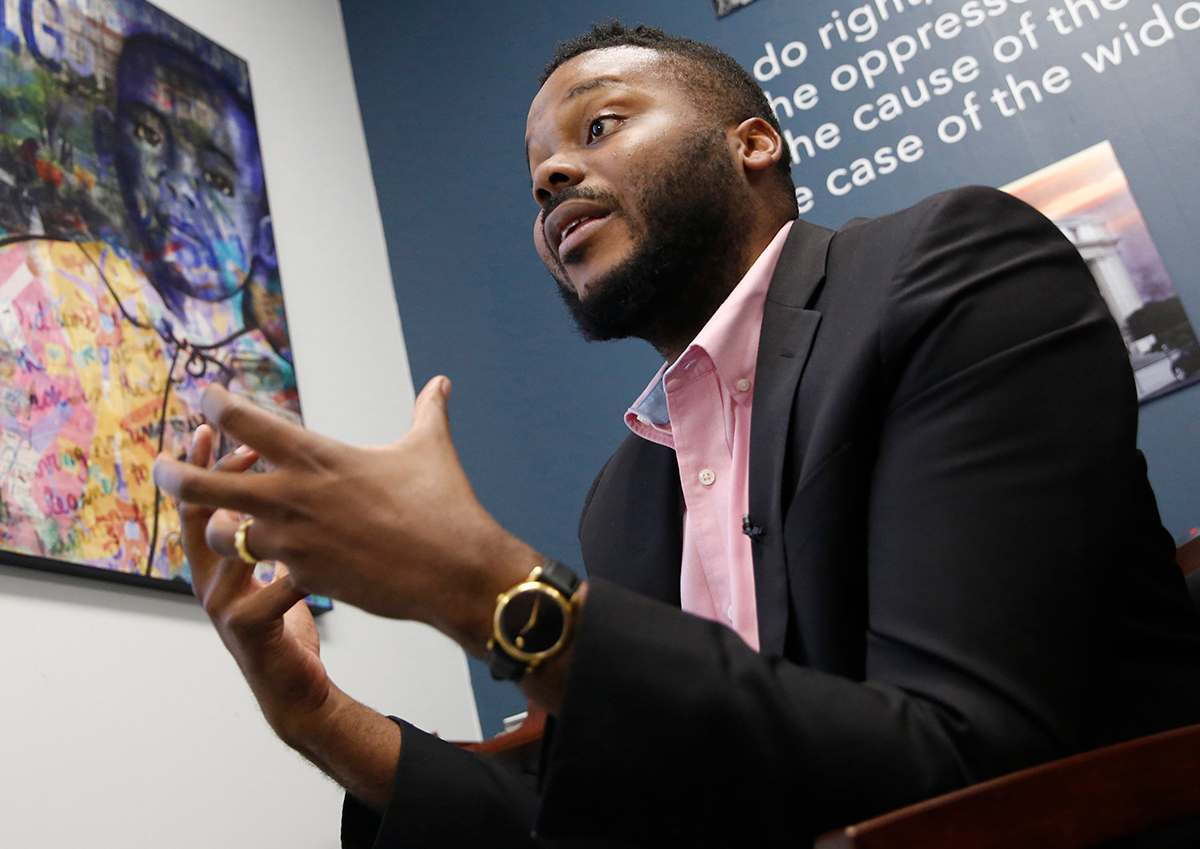Universal basic income is here—it just looks different from what you expected
How the pandemic took the concept of universal basic income out of Silicon Valley’s hands—and turned it into something far more radical.

Several years ago, when Elizabeth Softky first heard of the concept of universal basic income, she had her doubts. She was a public school teacher at the time, and she knew how hard it was to convince people to support even modest financial benefits, like pay raises for her coworkers. “Giving people money? I couldn’t wrap my head around it,” she says. “You can’t just give people money.”
But that was before she was diagnosed with colon cancer, before aggressive chemotherapy left her unable to work and unable to pay the rent, before she was evicted from her home in Redwood City, California, and before she moved into an area homeless shelter. It was also before she got the call saying she was being accepted into a program offering six monthly payments of $500 to 15 people experiencing homelessness.
It was December 2020, and she was being invited into a pilot program, run by the non-profit Miracle Messages, providing guaranteed income—a direct cash transfer with no strings attached. For Softky, it was a lifeline. “For the first time in a long time, I felt like I could … take a deep breath, start saving, and see myself in the future,” she says.
The idea of “just giving people money” has been in and out of the news since becoming a favored cause for many high-profile Silicon Valley entrepreneurs, including Twitter’s Jack Dorsey, Facebook cofounders Mark Zuckerberg and (separately) Chris Hughes, and Singularity University’s Peter Diamandis. They proposed a universal basic income as a solution to the job losses and social conflict that would be wrought by automation and artificial intelligence—the very technologies their own companies create.
But while prominent names in technology are still involved today, especially when it comes to funding projects, the conversation has changed. Its center of gravity has shifted away from “universal basic income” aimed at counterbalancing the automation of work and toward “guaranteed income” aimed at addressing economic and racial injustices.
How guaranteed income came to be
First proposed by philosophers in the 16th century, the idea of an income delivered directly by the state has been seen in many quarters as a balm for all kinds of social ills. Progressives argue that a guaranteed minimum income has the potential to lift communities out of poverty. Some conservatives and libertarians, meanwhile, see universal basic income as a cost-effective alternative to existing social welfare systems.
In the United States, proponents of guaranteed income as a matter of economic justice have included the Black Panthers and Martin Luther King Jr., while the libertarian economist Milton Friedman advocated it as a form of negative income tax. Even President Richard Nixon proposed providing cash directly to families, without conditions. His plan—produced after 1,000 economists urged it in an open letter—twice passed the House, but got rejected by the Senate.
Tech-sector proponents of UBI tend to be driven by the libertarian model. It aligns both with their core beliefs about the future and with their primary theory of change. While it is not a technological solution per se ... it also kind of is. It’s the ultimate hack to get around the complexities of creating equitable social welfare policies.

It’s very much “in keeping with modern Silicon Valley's excitement for alternative policy experiments and ideas,” says Margaret O’Mara, a professor at the University of Washington who has written extensively on the history of the tech industry. “Like, ‘Okay, the regular systems and institutions aren’t working, and here’s this one cool trick.’”
When the concept of UBI began taking hold in Silicon Valley, many proponents looked outside the US for case studies. In 2017, Finland launched a two-year plan giving monthly payments to 2,000 unemployed citizens. In Canada, the government of Ontario announced a three-year program that was cut short when a more conservative party took control of the government. There have also been pilots in Iran, Spain, the Netherlands, and Germany.
But the United States has precedents as well. When Nixon was considering his own guaranteed income plan, studies were carried out in cities including Denver and Seattle. Since 1982, the Alaska Permanent Fund has given out a share of the state’s oil revenues to every adult resident (an average of $1,100 each year). A number of Native American tribes pay a share of casino revenues to every registered member. These American systems have shown almost no impact on the rate of employment—people don’t quit their jobs, one of the common concerns voiced by critics—but have led to improved outcomes in education, mental health, and crime.
Even so, there’s something that has felt inherently un-American about UBI. That’s why Softky objected when she first heard it discussed on the radio—“Because I was a good American,” she explains. (The implication being that a good American wouldn’t take handouts.)
"For the first time in a long time, I felt like I could … take a deep breath, start saving, and see myself in the future."
Former presidential hopeful Andrew Yang understood this cognitive barrier of “Americanness” when he proposed UBI as the centerpiece of his 2020 campaign for the Democratic nomination. He knew that what he decided to name his plan to mail monthly $1,000 checks to every American would be crucial to getting a positive reception, and so he workshopped multiple options before landing on “freedom dividend.”
After all, capitalism has become synonymous with the American dream, and what’s more capitalistic than a dividend? And freedom ... well, that part speaks for itself.
Getting a fair shot
By the time Yang launched himself onto the presidential debate stage, a number of basic income pilot projects in American cities were starting to generate data.
One was the Magnolia Mother’s Trust (MMT), a guaranteed income pilot project in Jackson, Mississippi, that specifically targeted low-income Black mothers. In December 2018, its first cohort of 20 mothers received their first $1,000, and they would receive the same sum every month for a year (they were also given savings accounts for their children). For many, the $12,000 effectively doubled their annual income. The program has since added two more cohorts of 110 women each.

The focus on Black mothers was intentional, says Aisha Nyandoro of Springboard to Opportunity, the nonprofit behind MMT: “When we look at poverty in this country and who has been harmed the most,” she says, “it’s Black women.” The group also chose to start savings accounts for the children to address the fact that poverty in the US is often generational.
“So how do we go about ensuring that we are supporting well that population that has been marginalized?” Nyandoro asks.
While the analysis is not complete, early results are promising. Compared with a control group, the pilot participants were 40% less likely to incur debt for emergency expenses and 27% more likely to visit a doctor. On average, they were able to set aside $150 each month for food and household expenses.
But for Nyandoro, these measurable “capitalistic outcomes” were only part of the story. They were important, but so were the dignity and agency that it returned to recipients. “For so many of the families that we work with,” she says, “they have not had someone to say to them, ‘You don’t have to prove that you deserve this. You simply deserve it because you are.’”
In other words, guaranteed income wasn’t about handouts, but about giving everyone—starting with the most marginalized individuals—a chance at a fair shot.
The power of narrative
Giving everybody a fair shot was also the mission of Michael Tubbs, then the newly elected mayor of Stockton, California, when he launched his city’s guaranteed income experiment in February 2019 and became the face of the renewed movement.
The Stockton Economic Empower Demonstration, or SEED, gave 125 randomly selected residents $500 a month for 18 months. It garnered plenty of attention—Tubbs and his efforts were even profiled in an HBO documentary—and drew funding from Chris Hughes’s nonprofit, the Economic Security Project. Results were encouraging. Most of the money went toward fulfilling basic needs. Food made up the largest spending category (37%), whereas just 1% was spent on alcohol or tobacco (an outcome that opponents had worried about). Meanwhile, rather than dropping out of the workforce, participants found jobs at twice the rate of a control group.
Buoyed by this success, Tubbs started an organization, Mayors for Guaranteed Income, to expand his city’s pilot. To date, 42 mayors across America have signed on, and additional projects are now being run in towns and cities from Hudson, New York, and Gary, Indiana, to Compton, California.
Since the results of SEED’s first year were released in March, Tubbs has often been asked what he learned from it. “I am tempted to say ‘Nothing,’” he told me in late March.
He means the pilot didn’t tell him anything that wasn’t already obvious to him: he knew from personal experience that many stereotypes about poor people (especially poor Black people) are not, as he put it, “rooted in reality.”
Tubbs was born in Stockton to a teenage mother and an incarcerated father. He attended Stanford on a need-based scholarship, and returned home after graduation. Soon he was elected to City Council, before becoming mayor when he was just 26.
Tubbs didn’t need the data to know he could trust people to make rational financial decisions, but the experience did help him “learn the power of narrative.”
He recognized that “sometimes ideology, sometimes racism,” colors people’s perceptions. Part of his job as mayor became to “illustrate what’s real and what’s not,” he says. He saw the chance to “illustrate what’s actually backed by data and what’s backed by bias.”
The need to change narratives through research and evidence was also apparent to Nyandoro, of Magnolia Mother’s Trust. A few days before the third cohort began receiving money, I asked her what research questions she hoped this new cycle would answer.
“We have more than enough data now to prove that cash works,” she told me. Now her question was not how cash would affect low-income individuals but, rather, “What is the data or talking points that we need to get to the policymakers ... to move their hearts?” What evidence could be sufficient to make guaranteed income a federal-level policy?
As it turned out, what made the difference wasn’t more research but a global pandemic.
The pandemic effect
When stay-at-home orders closed many businesses—and destroyed jobs, especially for already vulnerable low-income workers—the chasm of American inequality became harder to ignore. Food lines stretched for miles. Millions of Americans faced eviction. Students without internet access at home resorted to sitting in public parking lots to hook into Wi-Fi so they could attend classes online.
This was all worse for people of color. By February 2021, Black and Hispanic women, who make up only a third of the female labor force, accounted for nearly half of women’s pandemic job losses. Black men, meanwhile, were unemployed at almost double the rate of other ethnic groups, according to Census data analyzed by the Pew Research Center.
All this also changed the conversation about the costs of guaranteed income programs. When the comparison was between basic income and the status quo, they’d been seen as too expensive to be realistic. But in the face of the recession caused by the pandemic, relief packages were suddenly seen as necessary to jump-start the American economy or, at the very least, avoid what Jerome Powell, then chairman of the Federal Reserve, called a “downward spiral” with “tragic” outcomes.
"Covid-19 really illustrated all the things that those of us who actually work with, and work for, and are in relationship with, folks who are economically insecure know."
“Covid-19 really illustrated all the things that those of us who actually work with, and work for, and are in relationship with, folks who are economically insecure know,” says Tubbs. That is, poverty was not an issue of “the people. It’s with the systems. It's with the policies.”
Stimulus payments and increased unemployment benefits—that is, direct cash transfers to Americans with no conditions attached—passed with huge public support. And earlier this year, an expanded Child and Dependent Tax Credit (CTC) was introduced that provides up to $3,600 per child, paid in monthly installments, to most American families.
This new benefit, which is set to last for a year, is available even to families that don’t make enough money to pay income tax; they had been left out of previous versions of the tax credit. And by sending monthly payments of up to $300 per child, rather than a single rebate at the end of the year, it gives families a better chance to plan and budget. It is expected to cut child poverty in half.
Washington might not have used the language of guaranteed income, but these programs fit the definition.
The CTC is “a game changer,” says Natalie Foster, a cofounder of the Economic Security Project, which funded many of the guaranteed income pilots, including both SEED and Mayors for Guaranteed Income. It “overturns decades of punitive welfare policies in America,” she says, and sets the stage for more permanent policies.
Whereas her organization originally thought it might take a decade of data from city-based pilot programs to “inform federal policymaking,” the CTC means that guaranteed income has, at least temporarily, arrived.
The stimulus bills and CTC also make Tubbs “more bullish now than ever” that guaranteed income could soon become a permanent fixture of federal policy.
“We live in a time of pandemics,” he says. “It’s not just covid-19. It’s an earthquake next month. It’s wildfires. All these things are happening all the time—not even mentioning automation. We have to have the ability for our folks to build economic resilience.”

But even if the rhetoric has shifted away from the technocratic concept of UBI, Silicon Valley’s interest in universality hasn’t gone away. Last April, Jack Dorsey announced a new philanthropic initiative, Start Small LLC, to give away $1 billion.
The donations would focus initially on covid-19 relief and then, after the pandemic, shift to universal basic income and girls’ education, he said. Putting money toward these causes, Dorsey explained, represented “the best long-term solutions to the existential problems facing the world.”
Despite its announced focus on universal basic income, StartSmall has become one of the largest funders of guaranteed income. It donated $18 million to Mayors for Guaranteed Income, $15 million to the Open Research Lab (previously known as the Y Combinator basic income experiment), $7 million to Humanity Forward, Andrew Yang’s foundation, and most recently $3.5 million to establish a Cash Transfer Lab at New York University to conduct more research on the issue.
Yang, now running for mayor of New York City, has also shifted away from his focus on universality. Rather than sending $1,000 checks every month to everyone, he now advocates for a guaranteed minimum income of $2,000 per year for New Yorkers living in extreme poverty.
Tubbs claims some credit for these shifts. He recalls a conversation with Dorsey in which he told the billionaire, “It’s gonna take time to get to universality, but it’s urgent that we do guaranteed income… So look, we’re not going to ... test a UBI. We can test the income guarantee. Let's start there.”
If his donations are any indication, Dorsey took Tubbs’s words to heart. What’s still unclear, however, is whether he and other tech leaders see guaranteed income as a stepping-stone to UBI or as an end in itself. (Neither Dorsey nor Start Small staff responded to requests for an interview.)
Scott Santens, one of the earliest “basic income bros,” believes that the tech sector’s initial interest in UBI as a fix for job loss is still relevant. The pandemic has led to an increase in sales of automation and robots, he says, pointing to reports that inquiries about Amazon’s call center tech have increased, as have purchases of warehouse robots to replace warehouse workers.
Meanwhile, Sam Altman, who helped kick off Y Combinator’s UBI experiment before leaving to head the artificial-intelligence startup OpenAI, wrote a recent manifesto about the situation. In it, he urged that we remain focused on the bigger picture: even if the pandemic has caused a short-term shock, it is technology—specifically, artificial intelligence—that will have the greatest impact on employment over time.
Altman called for the UBI to be funded by a 2.5% tax on businesses. “The best way to improve capitalism is to enable everyone to benefit from it directly as an equity owner,“ he wrote.
But would “everyone” include people of color, who are already being harmed at disproportionate levels by AI’s biases? And could a dividend paid out from the spoils of artificial intelligence make up for that harm? Altman’s manifesto notably leaves out any mention of race.
When reached for comment, he sent a statement through an OpenAI representative saying, “We must build AI in a way that doesn’t cause more harm to traditionally marginalized communities. In addition to building the technology in an equitable and just way, we must also find a way to share the benefits broadly. These are independently important issues.”
He did not respond to specific requests for comments on how AI was already harming Black communities, and how Black men are already being erroneously charged with crimes on the basis of faulty facial recognition.
Margaret O’Mara, the technology historian, notes that for technologists, one thing hasn’t changed during the pandemic: the assumption that technological progress is inevitable—and positive. That promotes an attitude of “Let’s figure out how to adjust society around it rather than saying, well, maybe we should try to prevent the displacement in the first place,” she says.
Tubbs, who recently cohosted a Clubhouse session with Altman, has a more generous—and straightforward—view of Silicon Valley’s role in the movement.
“I’m happy that they [technologists] are part of the conversation,” he says, because “a lot of revenue will come from them, or come from the products they make.”
At the end of the day, after all, it’s largely tech money that allowed him to put an extra $500 in the hands of his pilot participants every month. “Once that money is given,” he says, what happens next is “up to the person who has the money.”
But what if the harms caused by the tech sector are the reason recipients needed tech largesse in the first place?
When Elizabeth Softky became homeless in 2018, she wasn’t alone; Redwood City's gentrification at the hands of tech companies and workers was in full swing. Economic forces far beyond her control have shaped her personal ups and downs.
It’s “hyper-capitalism,” Softky says.
She was grateful, of course, for her six months of guaranteed income—but also aware of the broader challenges that a short-term program run by a small nonprofit could not solve. Softky says she hopes the organization will expand both the amount of money it’s giving out and the duration of the program. But far better would be for the government to do the same.
Deep Dive
Policy
Is there anything more fascinating than a hidden world?
Some hidden worlds--whether in space, deep in the ocean, or in the form of waves or microbes--remain stubbornly unseen. Here's how technology is being used to reveal them.
A brief, weird history of brainwashing
L. Ron Hubbard, Operation Midnight Climax, and stochastic terrorism—the race for mind control changed America forever.
What Luddites can teach us about resisting an automated future
Opposing technology isn’t antithetical to progress.
Africa’s push to regulate AI starts now
AI is expanding across the continent and new policies are taking shape. But poor digital infrastructure and regulatory bottlenecks could slow adoption.
Stay connected
Get the latest updates from
MIT Technology Review
Discover special offers, top stories, upcoming events, and more.